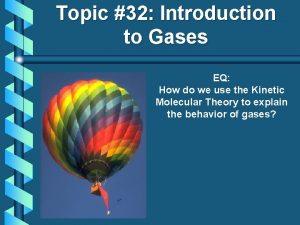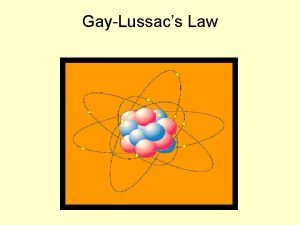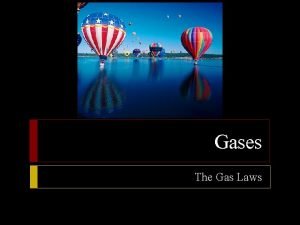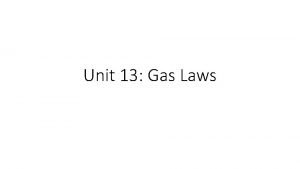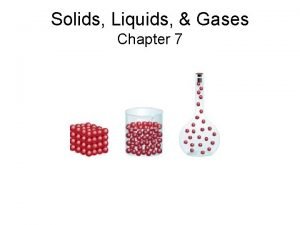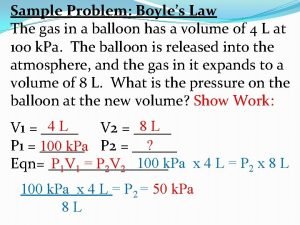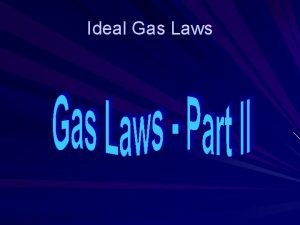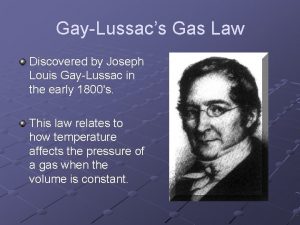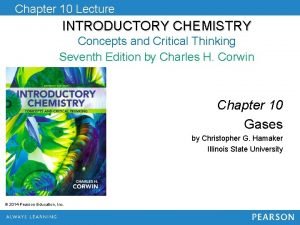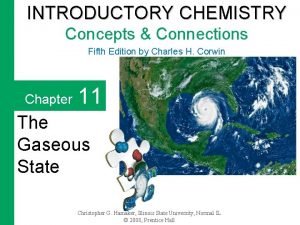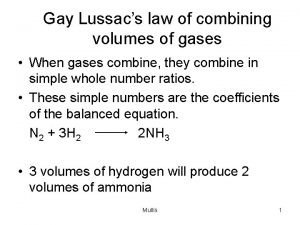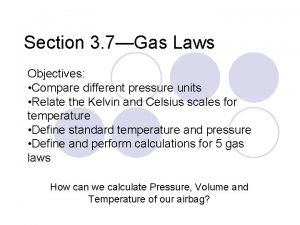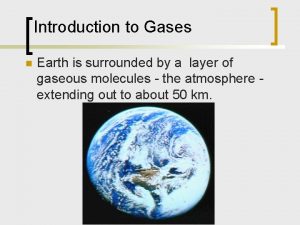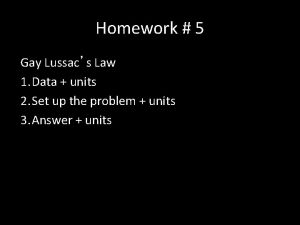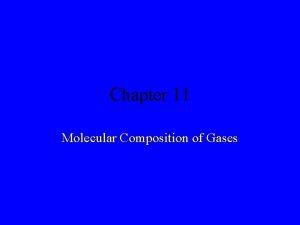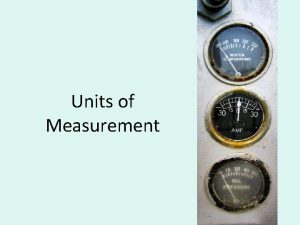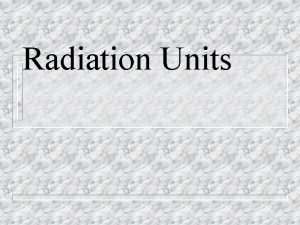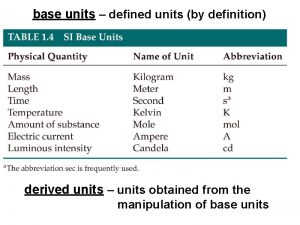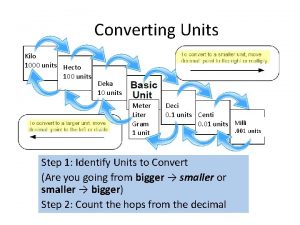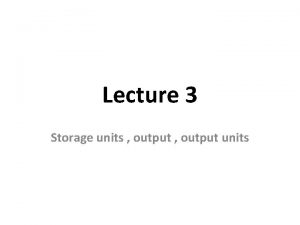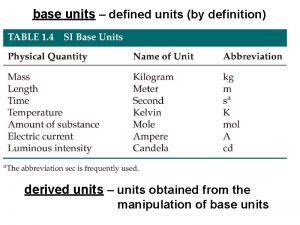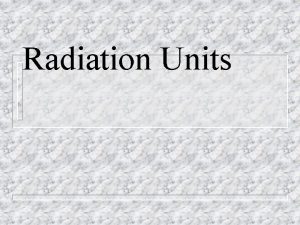Homework 5 Gay Lussacs Law 1 Data units


























- Slides: 26

Homework # 5 Gay Lussac’s Law 1. Data + units 2. Set up the problem + units 3. Answer + units

Aim 5: How can you describe Gay- Lussac’s Law?

Gay-Lussac’s Law • Discovered in 1802 by Joseph Gay-Lussac

The tank contains a gas ……. .

How much propane is in the tank? Propane tanks are widely used with barbeque grills. But it’s not fun to find out half-way through your grilling that you’ve run out of gas. You can buy gauges that measure the pressure inside the tank to see how much is left. The gauge measures pressure and will register a higher pressure on a hot day than it will on a cold day. So you need to take the air temperature into account when you decide whether or not to refill the tank before your next cook-out.

At a Constant Volume

Volume and number of particles are constant

What happens when you increase the temperature of the container? u Increased temperature leads to increase average velocity of the particles u. Increased average force per collision u. Increased rate of collision u. Increased pressure Increase Pressure

At a Constant Volume

At a Constant Volume

Think about a SCUBA tank where volume is constant. What happens to the molecular kinetics inside of it when you heat the tank? Since the particles are moving faster the number of collisions with the side of the tank increases, increasing the pressure.

1. Gay-Lussac Law • For a gas confined at a constant volume, the pressure and temperature are directly related.

2. Directly Proportional: P R E S S U R E Temperature

“At constant Volume” P 1 V 1 = P 2 V 2 T 1 T 2 P 1 = P 2 T 1 T 2

P 1 = P 2 T 1 T 2 P R E S S U R E P TEMPERATURE

1. Determine the pressure change when a constant volume of gas at 1. 00 atm is heated from 20. 0 °C to 30. 0 °C. P 1 = P 2 T 1 T 2 Data P 1= 1. 00 atm T 1 = 20. 0 °C = 293. 0 K P 2 = ? T 2 = 30. 0 °C = 303. 0 K

P 1 = P 2 T 1 T 2 P 2 = P 1 T 2 T 1 P 2 = 1. 00 atm x 303. 0 K 293. 0 K P 2 = 1. 03 atm

2. A gas has a pressure of 0. 370 atm at 50. 0 °C. What is the pressure at standard temperature? Data P 1= 0. 370 atm T 1 = 50. 0 °C = 323. 0 K P 2 = ? T 2 = 273 K (at standard temperature : table A)

P 2 = P 1 T 2 T 1 P 2 = 0. 370 atm x 273 K 323 K P 2 =0. 313 atm

3. If a gas in a closed container is pressurized from 15. 0 atmospheres to 16. 0 atmospheres and its original temperature was 25. 0 °C, what would the final temperature of the gas be? Data P 1= 15. 0 atm T 1 = 25 °C = 298 K P 2 = 16. 0 atm T 2 =

T 2 = P 2 T 1 P 1 T 2 = 16. 0 atm x 298 K 15 atm T 2 = 317. 87 K

• 760 mm. Hg = 101. 3 KPa

4. A gas has a pressure of 699. 0 mm Hg at 40. 0 °C. What is the temperature at standard pressure? Data P 1= 699. 0 mm Hg T 1 = 40. 0 °C = 313 K P 2 = 760. 0 mm Hg (at standard pressure) T 2 = ? *1 atm= 101. 3 Kpa= 760 mm Hg

P 1 = P 2 T 1 T 2 = P 2 T 1 P 1 T 2 = 760 mm Hg x 313 K 2 sf 3 sf 699. 0 mm Hg 4 sf T 2 = 340 K (2 sf)

5. If a gas is cooled from 323. 0 K to 273. 15 K and the volume is kept constant what final pressure would result if the original pressure was 750. 0 mm Hg? Data P 1= 750. 0 mm Hg T 1 = 320 K P 2 = ? T 2 = 273. 15 K

P 2 = P 1 T 2 T 1 P 2 = 750. 0 mm Hg x 273. 15 K 320 K P 2 = 640 mm Hg
 Gay lussac's law formula
Gay lussac's law formula Gay lussac law
Gay lussac law Gay lussac's law
Gay lussac's law Unit 13
Unit 13 Mathematical equation of gay lussac's law
Mathematical equation of gay lussac's law Boyle's law examples
Boyle's law examples Gay lussac's law of combining volumes
Gay lussac's law of combining volumes What gas law was discovered by joseph louis gay lussac
What gas law was discovered by joseph louis gay lussac Gay lissacs law
Gay lissacs law Gay lussac's law
Gay lussac's law Charles law example problem
Charles law example problem Law of combining volumes
Law of combining volumes Homework oh homework i hate you you stink
Homework oh homework i hate you you stink Homework oh homework i hate you you stink
Homework oh homework i hate you you stink Parts of a poem
Parts of a poem Homework i love you poem
Homework i love you poem Alitteration definition
Alitteration definition Literal language example
Literal language example Botox dosage chart
Botox dosage chart Income statement for absorption costing
Income statement for absorption costing Newton's first law and second law and third law
Newton's first law and second law and third law Newton's first law and second law and third law
Newton's first law and second law and third law Boyle's law charles law avogadro's law
Boyle's law charles law avogadro's law Avogadro's law constant
Avogadro's law constant Avogadro's law units
Avogadro's law units Boyle's law variables
Boyle's law variables Units of hubble constant
Units of hubble constant
